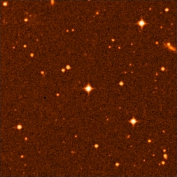JINA co-I Beers and Colleagues Discover Record Low Abundance Star
Michigan State University professor, and JINA co-I, Timothy Beers is part of an international team of astronomers that has identified an ancient star, one of a pair of objects with the lowest observed abundances of heavy metals ever discovered. JINA visitors Anna Frebel (Australian National University), presently a graduate student and the lead author of the study, Norbert Christlieb (Hamburger Sternwarte), and John Norris (Australian National University) completed the early stages of this work while in residence at MSU last summer.
The research is detailed in the April 14 issue of the journal Nature. (Details) The newly discovered star, known as HE1327-2326, is similar in age and chemical composition to another star Beers and his colleagues discovered three years ago. Both stars are approximately 13 billion to 14 billion years old, with extremely low levels of iron and other heavy metals. It is of particular interest that these two stars have patterns of elemental abundances that are quite similar to one another, said Beers, with extremely large amounts of light elements such as carbon, nitrogen and oxygen. |
 HE 1327 Color |
"We are looking at a new class of stars here," Beers said. "It cannot be a coincidence that the two lowest metallicity stars ever discovered share these same traits. These stars may have recorded the patterns of elements created by the very first generations of massive stars to have formed in the universe."
The clue to these stars' age is the fact that they have extremely low metal content. Beers said these stars have less than 1/200,000th of the solar content of heavy elements, which is about 20 times more metal-poor than the previous record for stars in the Milky Way galaxy.
HE 1327-2326 was initially identified as part of observations currently being made of candidate low-metallicity stars chosen from the Hamburg/ESO Objective Prism survey. Subsequent high-resolution spectroscopy were obtained with the 8-meter Japanese National Telescope, "Subaru," located on Mauna Kea in Hawaii.
This star is approximately 5,000 light years from Earth. Not visible with the naked eye, it is located in the constellation Hydra.
When stars began to form some time after the Big Bang, the only abundant elements in the universe were hydrogen and helium. The first stars to form are thought to have been hundreds of times more massive than our sun.
After extremely short lives, these stars exploded as supernovae and began to pollute the universe with heavier metals such as iron, carbon, nitrogen and oxygen. Consequently, the older stars have very low levels of these metals.
In addition to Beers, other members of the team are from Australia, Germany, Japan, Sweden and the United Kingdom.
 See the related article in the same issue: -- "News and Views" --
Two's Company by Roger Cayrel
See the related article in the same issue: -- "News and Views" --
Two's Company by Roger Cayrel
The Joint Institute for Nuclear Astrophysics
April 14, 2005